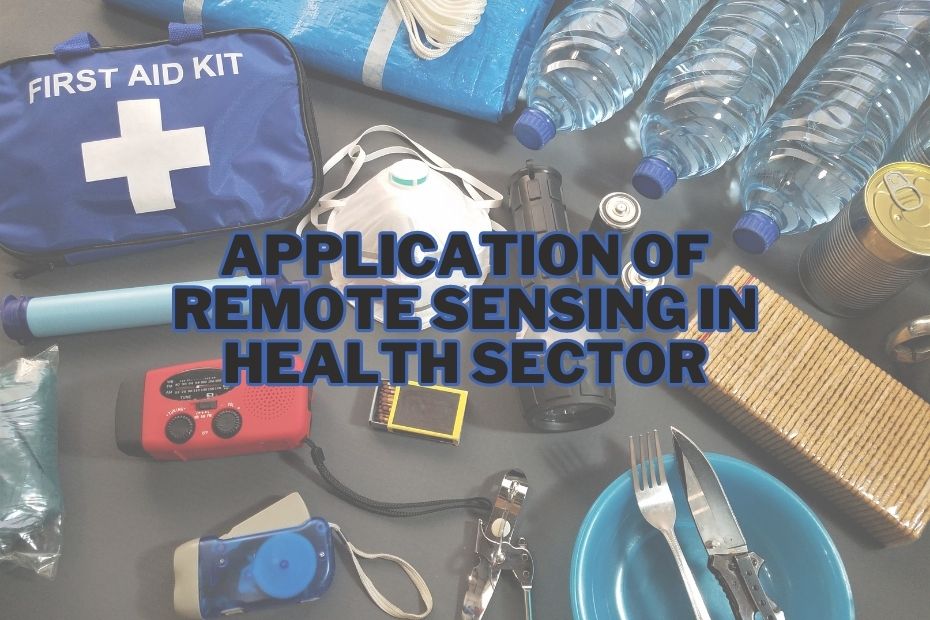Remote sensing, a technology that involves the collection of data from a distance, has found numerous applications in various fields. One such area where remote sensing has made significant strides is the health sector. This article delves into the essential application of remote sensing in health sector, highlighting its impact and potential in improving medical services and public health outcomes.
By using satellites and remote sensing technologies, healthcare professionals can track disease outbreaks, assess environmental risks, and enhance healthcare access in remote areas. This integration of remote sensing in the health sector has revolutionized disease surveillance and healthcare planning, leading to more efficient and effective public health interventions.
Application of Remote Sensing In Health Sector
The application of remote sensing in health sector has opened new avenues for monitoring, disease control, disaster response, and much more. We will explore the diverse applications of remote sensing in revolutionizing the healthcare industry.
1. Monitoring Disease Outbreaks
One of the most critical applications of remote sensing in the health sector is its ability to monitor disease outbreaks. By utilizing satellite imagery and other remote sensing technologies, health authorities can identify and track the spread of diseases more effectively. Timely detection allows for rapid response measures, helping to contain outbreaks and prevent their escalation.
2. Assessing Environmental Health Risks
Remote sensing enables the assessment of environmental health risks, which play a significant role in public health. By analyzing remote data, we can identify pollution sources, hazardous areas, and potential health hazards. This information aids policymakers in implementing appropriate measures to safeguard communities from environmental health risks.
3. Vector-Borne Disease Control
Vector-borne diseases, such as malaria and dengue, pose significant health threats globally. Remote sensing assists in mapping and monitoring vector habitats, helping to predict outbreaks and develop targeted control strategies. By analyzing climate data and environmental factors, remote sensing contributes to effective vector-borne disease control.
4. Monitoring Respiratory Diseases
Respiratory diseases, including asthma and chronic obstructive pulmonary disease (COPD), are widespread and impact millions worldwide. Remote sensing technologies aid in monitoring air quality, identifying pollution sources, and understanding the correlation between environmental factors and respiratory health. This information guides health interventions and pollution control measures.
5. Disaster Response and Management
During natural disasters and emergencies, quick and efficient responses are crucial for saving lives. Remote sensing tools, such as aerial imagery and drones, provide real-time data on disaster-affected areas. This data aids in assessing the extent of damage, identifying affected regions, and planning rescue operations and resource allocation.
6. Tracking Infectious Diseases
Infectious diseases can spread rapidly, making their containment challenging. Remote sensing technologies offer valuable insights into disease dynamics by analyzing population movements, urbanization, and environmental changes. This information aids in predicting disease spread patterns, facilitating targeted interventions.
7. Managing Epidemics
Remote sensing’s role in managing epidemics extends beyond disease monitoring. It also involves resource planning, infrastructure management, and logistics coordination. By analyzing population density and movement, healthcare authorities can efficiently allocate medical supplies, personnel, and equipment during epidemics.
8. Remote Patient Monitoring
Remote sensing has made significant strides in remote patient monitoring, especially in telemedicine. Wearable devices and remote sensors allow healthcare providers to monitor patients’ vital signs, chronic conditions, and overall health status from a distance. This enables timely interventions and reduces the need for in-person visits.
9. Environmental Impact Assessment for Healthcare Facilities
When establishing new healthcare facilities, considering environmental impact is vital. Remote sensing aids in conducting environmental impact assessments, analyzing factors such as land use, vegetation, and accessibility. This information helps in selecting suitable locations that minimize adverse environmental effects.
10. Identifying Suitable Locations for Medical Facilities
In addition to environmental impact assessments, remote sensing also helps identify suitable locations for medical facilities. By analyzing population distribution, demographics, and health indicators, decision-makers can strategically position healthcare facilities where they are most needed.
11. Health Informatics and Data Analytics
Remote sensing generates vast amounts of data that, when analyzed through health informatics and data analytics, can offer valuable insights. From disease trends to resource utilization, this data-driven approach enhances healthcare decision-making and planning.
12. Monitoring Sanitation and Hygiene
Maintaining proper sanitation and hygiene is crucial for preventing the spread of diseases. Remote sensing can be used to monitor sanitation practices, waste management, and water quality, ensuring healthier communities.
13. Telemedicine and Remote Consultations
Telemedicine has gained prominence in recent years, enabling remote consultations between healthcare providers and patients. Remote sensing technologies facilitate telemedicine by ensuring reliable communication infrastructure and supporting seamless virtual healthcare services.
14. Food and Water Security
Access to safe and sufficient food and water is fundamental to public health. Remote sensing aids in monitoring agricultural activities, water resources, and food production, contributing to better food and water security planning and management.
Conclusion
In conclusion, remote sensing is revolutionizing the healthcare sector with its diverse applications. From disease monitoring and disaster management to telemedicine and environmental assessments, this technology is transforming how healthcare services are delivered and public health challenges are addressed. As technology continues to evolve, the integration of remote sensing into healthcare promises even greater advancements, leading to improved health outcomes for individuals and communities worldwide.
FAQs: Application of Remote Sensing In Health Sector
How does remote sensing help in disease monitoring?
Remote sensing provides data on environmental factors that impact disease outbreaks, aiding in disease monitoring and response.
What role does remote sensing play in disaster management?
Remote sensing offers real-time data on affected areas during disasters, helping prioritize rescue efforts and resource allocation.
Can remote sensing assist in identifying suitable locations for medical facilities?
Yes, remote sensing data can help identify regions with high healthcare demands, guiding the establishment of medical facilities where needed.
